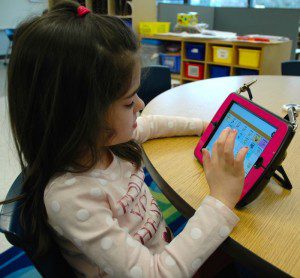Your speech-language pathologist/speech therapist may recommend that your child could benefit from AAC, but what is AAC?
Augmentative and Alternative Communication (AAC) is a term used to encompass all forms of communication, other than oral speech, to express thoughts, needs, wants, and ideas. We all use AAC to communicate throughout the day. We may use gestures and facial expressions to supplement our oral speech. We may email, text, or even use emojis, as additional ways to communicate in a variety of environments.
Children and adults with speech-language difficulties rely on AAC to supplement speech or provide more functional communication. AAC users should never stop using what verbal communication they have. Instead, AAC should enhance your child’s existing communication.
Children in speech-language treatment can benefit from a variety of AAC options. Most often the speech therapist will implement manual sign language, picture icons, communication boards/books, or speech generating devices (SGDs). Speech generating devices allow your child to use picture symbols, letters, or words to communicate with an electronic device. Research shows more positive outcomes with children who receive speech-language intervention in the early years of development, so it is important to think about your child’s use of age-appropriate concepts and word combinations if they have limited oral speech.
AAC Myths:
* My child is too young to use AAC.
* AAC will keep my child from talking.
* I must try low technology AAC before providing a speech generating device.
* If my child has some speech, then AAC is not needed.
* If my child can express basic needs, then AAC is not needed.
* AAC can only be implemented by the speech-language pathologist (SLP).
Talk to a speech-language pathologist today at Chicago Pediatric Therapy & Wellness Center if you are having concerns with your child’s expressive language skills!
DeThorne, L., Johnson, C., Walder, L., & Mahurin-Smith, J. (2009). When “Simon Says” doesn’t work: Alternatives to imitation for facilitating early speech development. American Journal of Speech-Language Pathology, 18
Schlosser, R., & Wendt, O., (2008). Effects of augmentative and alternative communication intervention on speech production in children with autism: A systematic review. American Journal of Speech-Language Pathology, 17, 212-230.
Millar, D., Light, J., & Schlosser, R. (2006). The impact of augmentative and alternative communication intervention on the speech production of individuals with developmental disabilities: A research review. Journal of Speech, Language and Hearing Research, 49, 248







